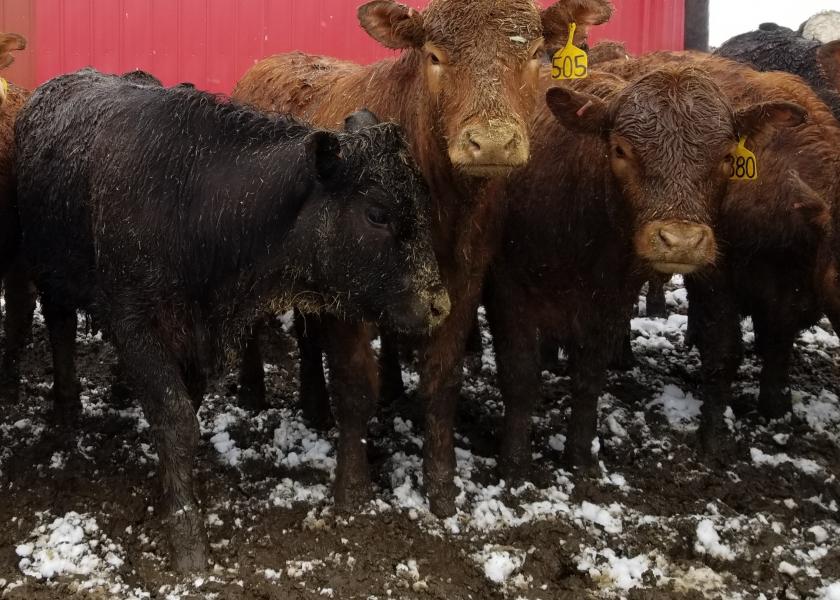Flooding Could Force Producers to Move Cattle

Wet, muddy ground and flooding are likely in the Central Plains this spring, so producers need to be prepared to deal with those conditions or even move cattle and the equipment to feed and care for them to higher ground, North Dakota State University Extension livestock specialists advise.
“Providing improved drainage in the yard can hasten drying conditions,” says Karl Hoppe, Extension livestock systems specialist at NDSU’s Carrington Research Extension Center. “It might be as simple as using a hand spade or a loader bucket or land scraper to improve drainage.”
The bigger issue this spring will be the amount of mud created when the frozen ground thaws. Producers may have trouble reaching feedstuffs in yards with softening ground.
“The options are somewhat limited to deal with this, and front-wheel-assist tractors are a necessity when conditions become very difficult,” says John Dhuyvetter, Extension livestock systems specialist at NDSU’s North Central Research Extension Center near Minot. “However, conditions may be beyond even the best efforts of the equipment and operator.”
Producers may need to move big round hay bales to higher ground, which can result in hay loss because twine- or net- wrapped bales will be frozen to the ground and hay can be left where the bales were stored. If producers use coproducts such as beet pulp, beet tailings or distillers grains to feed their cattle, road restrictions limit their ability to haul in new feed. Also, storing these wet products on the ground outdoors can contribute to muddier conditions.
Animal Health
Animal health also is a concern this spring.
“Cows that are calving in confinement need to be moved when more than 6 to 10 inches of mud exist on pen surfaces,” NDSU Extension veterinarian and livestock stewardship specialist Gerald Stokka says. “Adult cows can deal with this, but newborn calves will need space inside a bedded barn, or cows with newborn calves will need to be moved to firmer footing.”
Excess mud in calving areas will decrease calves’ ability to rise and nurse. This inhibits their colostrum consumption, which increases their risk of disease, especially neonatal calf scours. Colostrum is a form of milk that mammals produce in late pregnancy. It contains energy, protein, fat and vitamins, plus antibodies to protect newborns against disease until their own immune system is totally functional.
“In addition, cows in muddy conditions may have very dirty udders and teats, which contributes to increased pathogen exposure to the calf,” says Janna Block, livestock systems specialist at NDSU’s Hettinger Research Extension Center.
“Having mounds in confinement is important to providing relief to animals from muddy conditions,” she notes. “However, building mounds to prepare for muddy conditions must be done the previous year.”
Mounds can be bedded and designed with walkways so animals have access to water and feed without moving through deep mud. Cows should be provided a minimum of 500 to 1,000 square feet of space per head.
Calving Issues
All cows that appear to be close to calving in a 24-hour period should be moved into a calving barn. Depending on herd and barn size, the entire barn may be bedded, and all cows calving within the 24-hour period should be moved, if possible, to sod or clean, dry ground.
Pens can be constructed of panels if working with first-calf heifers because they may lack mothering ability and may need some assistance in establishing a bond with their calf.
“The calving barn must be kept with clean bedding because midway and later into the calving season, potential pathogens can raise the risk to calves moving through the facility,” says Lisa Pederson, Extension livestock specialist at NDSU’s Central Grasslands Research Extension Center.
Without a calving barn and under extreme muddy conditions, finding sod that can be cleared of snow is an option.
“Each cow close to calving should be provided at least 0.5 acre per cow for proper space to calve and reduce the risk of pathogen exposure,” Stokka says. “If conditions still are less than ideal after two weeks of calving, clear and move to another area and leave behind the contaminated area.”
He adds that in extreme weather conditions, producers could provide calf shelters. However, the shelters should be moved often to reduce the risk of pathogen exposure to the calf crop.
In addition, Stokka urges producers to monitor calf health, look for symptoms associated with calf scours and/or bloody diarrhea, along with depression.
“Also monitor calves that express lethargic behavior, lack of nursing and increased respiration,” he says. “If calf scours does develop, separate the calf and dam from the herd to limit its spread.”
Visit NDSU Extension's flood website at https://www.ag.ndsu.edu/flood/ for more information and resources.







